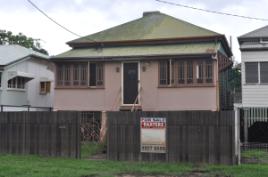Property market will come back on top after bumpy ride
Published on 07 February, 2011
Given time, the Queensland property market will regain its strength after suffering from the State's biggest flood disaster in recorded history.
As homes slowly dry out across the State, property owners will not only be counting the costs of restoring their homes (some even replacing) but they will be coming to terms with the impact on their property's value. Properties that have been inundated with water will undoubtedly face a stigma in the market, at least in the near future, but experts like CQUniversity's property lecturer and registered valuer, Ian Clarkson, are confident the Queensland property market will eventually come back on top.

On the market: Just one of a number of homes affected by the recent floods.However for now, first-home buyers who have borrowed close to 100% of market value will be the hardest hit as values take an immediate dive, forcing them to absorb the costs and stay put or face the fate of bigger losses. More experienced property buyers are expected to cope better and should be more equipped to ride the property cycle.
Mr Clarkson - who is a Fellow of the Australian Property Institute - believes despite this immediate price crunch, history shows us that memories fade and property values will eventually recover to some extent after these floods.
"As any economist, and anyone purchasing vegetables at the moment understands, when demand is high and stock is low prices rise; but the lower demand for flood areas immediately post flood tends to force prices to fall to meet the market."
He said other factors that will play their role in forcing values down will include the implication of property damage, lack of affordable insurance and a potentially tight credit market where banks may not be as keen on risky properties.
"Two things will negate the stigma of flood areas. One is time - as people generally diminish pain and problems with time, so do we forget. New people are bound to move into these areas looking for affordability and not fully understanding the implications of flood. The second is a market push or boom. People begin to seek out dwellings with an affordability focus ... this is when flood areas become interesting again. Investors can also be attracted to post-flood properties as a lower purchase price may mean higher returns on their investment, although with an inherent risk."
Rockhampton's recent history, post the 1991 flood, paints a pretty good picture of what regional Queensland can expect with property values. Long-serving real estate agent, Pat O'Driscoll, remembers the period that followed that flood and the eventual boom that saw flood-affected suburbs like Depot Hill become hot property for southern investors. (In 2006 more than a third of the suburb was owned by investors)
"The first quarter after the 1991 flood was a time of redirection and regaining of confidence of the market. Our records show that 1991 gathered momentum quickly, even through January, and proved to be a stronger year than some of the years of that decade."

Property valuer and lecturer Ian Clarkson."With the depth of industry growth within the region over this next decade, the demand for property throughout Central Queensland is expected to increase significantly in the short to medium term. There's need for both rental properties and owner-occupied homes during the expansion phases of the coal and gas industries, and with the support of the grazing, agricultural, tourism, health and educational sectors we anticipate a strong real estate market with increasing demand from all areas of Australia and beyond."
Managing Director of the Real Estate Institute of Queensland Ltd (REIQ) Dan Molloy is also holding hope that Brisbane and surrounding regions recover quickly, saying although it is still too early to tell with any level of certainty what effects the recent Queensland floods will have, we can take some heart from how the market reacted after the Brisbane 1974 floods. "The REIQ has researched the Greater Brisbane property sales market and found that within six to 12 months of the January 1974 flooding, demand and prices had returned to levels experienced pre-flood." Nonetheless, he said in the short term, properties directly affected by floods are obviously the most likely to be affected by lower demand and reduced prices.
Unlike many of Central Queensland's riverfront properties, most of which feature in the region's flood maps, Brisbane's waterfront is renowned for its exclusive address. With views of the water, personal jetties and elaborate facades, Mr Clarkson believes these million and multi-million dollar properties are less likely to feel the price pinch. Despite the devastating impact of the Brisbane River breaking its banks and swamping many of these properties, Brisbane's waterfront will continue to host sought-after properties.
Mr Molloy agrees, saying despite the scale of the latest flood he couldn't image Brisbane residents giving up their infatuation with the city's river. "Although the next few months will be difficult, at the end of the day there still will be that overall attraction of being close to the river because of the key role its plays in Brisbane's economy." However, other water-affected Brisbane properties behind the esplanades will probably suffer a decline in value in the short term.
With 27 years' experience in the Queensland property industry, from Brisbane and the Darling Downs to the Wide Bay and Capricornia, Mr Clarkson has seen the rise and fall of markets and understands what makes Queensland tick when it comes to property buying. He believes while many would never contemplate purchasing properties that are in flood zones, affordability of these properties and potentially higher returns for investors willing to risk the periodic floods on a lesser outlay will still attract a number of buyers, especially as memories fade.
Anecdotal reports from real estate agents suggest that even before the floods there was a shortage of rental properties across the State in the lower end market. This is also supported by Realestate.com.au which is advertising very few homes under $250 per week across the regions. With thousands of people reportedly seeking rental accommodation since the floods, the surge in demand will force rents up even more. Although bad news for renters, Harcourts Real Estate blogger Aaron Brooks said it could be a great time for investors to enter the property market. "We're sure to see incredibly low vacancy rates and high levels of demand over the coming months."
Property buyers however will need to do their homework. While property advice is often subject to opinion, the most common slogan bantered around is ‘Location, Location, Location', however Mr Clarkson believes this too is up for negotiation. "It really should be Location, from what?" He argues that home buyers should have a close look at their needs and choose a property that is located close to where their lives take them.
"It may not be advantageous to buy a home say on the Capricorn Coast if you constantly need to take children to Rockhampton for afterschool and weekend activities. An infirm person may find medical facilities and closeness to family a driving force whereas a young family may be thinking schools, shops, transport routes to work etc."
Investors should also take into account location, but as it relates to potential demand and desirability from tenants. "It is the demand which equals good rent, and good rent equals good returns as an investor is interested in return on investment and tax advantages," Clarkson said.
Mr Clarkson warns that the Australian property market cycles with booms and slumps. "In property you generally should be taking a medium to long-term outlook and not trying to get in and out for a quick dollar. That does occur, but not often. When a boom occurs, flood properties may become over-inflated with regard to price as people do not place enough emphasis on the risk factor in their calculations." The next boom therefore could be the best time to cash in on your investment.
In these post-flood times, Mr Molloy believes Queenslanders should be confident in their property investments. "While the next few months may result in a subdued market, we need to remember that hundreds of thousands of homes were not affected by the floods which should reassure homeowners and investors that the viability of the Queensland property market remains sound. As the rebuilding phase takes shape, and with it much-needed financial stimulus into our economy, the REIQ envisions that the property market will prove resilient as it did 37 years ago."

